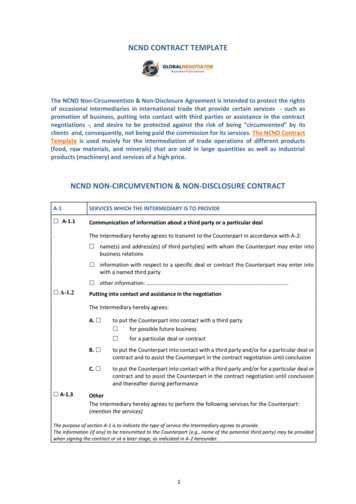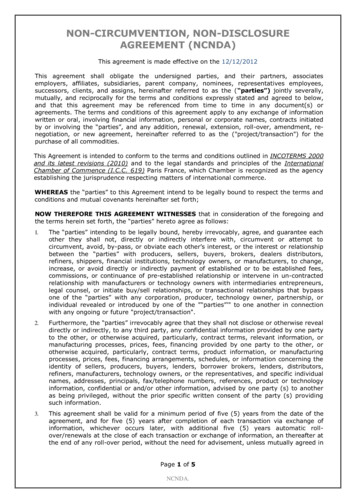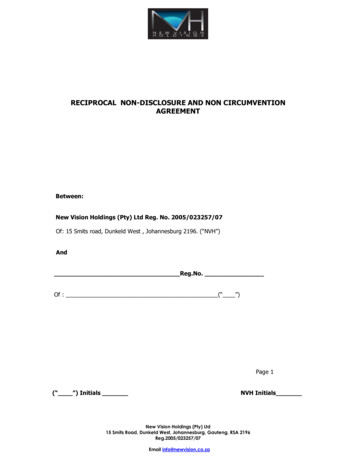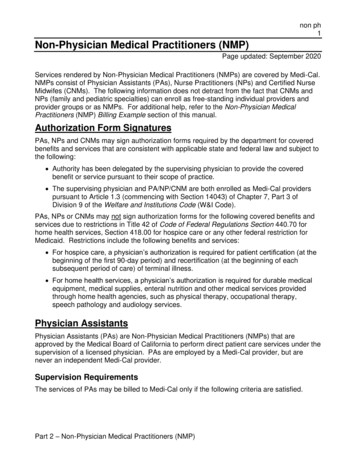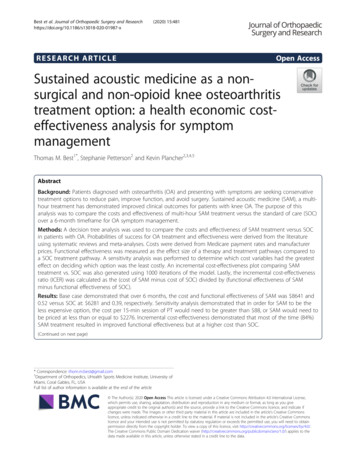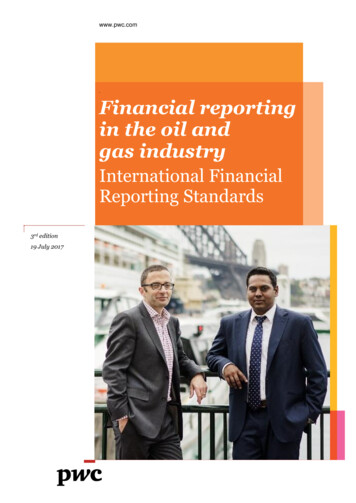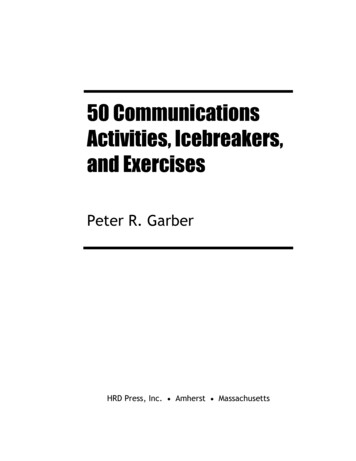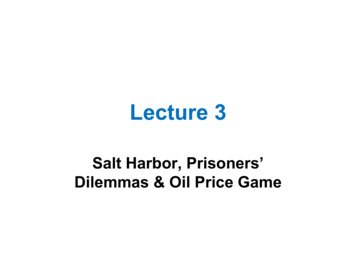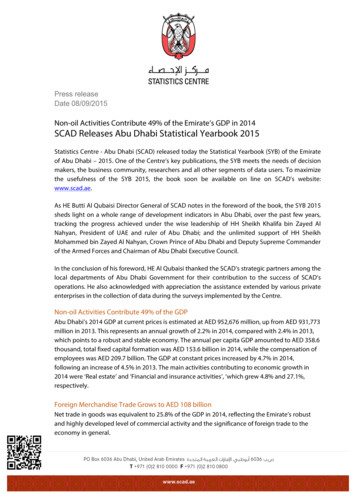
Transcription
Press releaseDate 08/09/2015Non-oil Activities Contribute 49% of the Emirate’s GDP in 2014SCAD Releases Abu Dhabi Statistical Yearbook 2015Statistics Centre - Abu Dhabi (SCAD) released today the Statistical Yearbook (SYB) of the Emirateof Abu Dhabi – 2015. One of the Centre’s key publications, the SYB meets the needs of decisionmakers, the business community, researchers and all other segments of data users. To maximizethe usefulness of the SYB 2015, the book soon be available on line on SCAD’s website:www.scad.ae.As HE Butti Al Qubaisi Director General of SCAD notes in the foreword of the book, the SYB 2015sheds light on a whole range of development indicators in Abu Dhabi, over the past few years,tracking the progress achieved under the wise leadership of HH Sheikh Khalifa bin Zayed AlNahyan, President of UAE and ruler of Abu Dhabi; and the unlimited support of HH SheikhMohammed bin Zayed Al Nahyan, Crown Prince of Abu Dhabi and Deputy Supreme Commanderof the Armed Forces and Chairman of Abu Dhabi Executive Council.In the conclusion of his foreword, HE Al Qubaisi thanked the SCAD’s strategic partners among thelocal departments of Abu Dhabi Government for their contribution to the success of SCAD’soperations. He also acknowledged with appreciation the assistance extended by various privateenterprises in the collection of data during the surveys implemented by the Centre.Non-oil Activities Contribute 49% of the GDPAbu Dhabi’s 2014 GDP at current prices is estimated at AED 952,676 million, up from AED 931,773million in 2013. This represents an annual growth of 2.2% in 2014, compared with 2.4% in 2013,which points to a robust and stable economy. The annual per capita GDP amounted to AED 358.6thousand, total fixed capital formation was AED 153.6 billion in 2014, while the compensation ofemployees was AED 209.7 billion. The GDP at constant prices increased by 4.7% in 2014,following an increase of 4.5% in 2013. The main activities contributing to economic growth in2014 were ‘Real estate’ and ‘Financial and insurance activities’, ‘which grew 4.8% and 27.1%,respectively.Foreign Merchandise Trade Grows to AED 108 billionNet trade in goods was equivalent to 25.8% of the GDP in 2014, reflecting the Emirate’s robustand highly developed level of commercial activity and the significance of foreign trade to theeconomy in general.
Commodity imports in goods through the ports of the Emirate Abu Dhabi amounted to AED108.0 billion in 2014, compared with AED 100.3 billion in 2014. The largest imports categoryduring 2014 was ‘Machinery, sound recorders, reproducers and parts’, which accounted for 23.7%of the total value. The United States of America was the top import partner, supplying theEmirate with goods worth AED 13.7 billion. Non-oil exports amounted to AED 19.0 billion, with‘Base metals and articles of base metals’ contributing 47.7% of the total. Saudi Arabia was the topdestination of Abu Dhabi’s non-oil exports, receiving goods worth AED 5.3 billion from theemirate in 2014. Re-exports worth AED 25.3 billion were shipped from Abu Dhabi ports in 2014,compared with AED 16.4 billion in 2013. The top re-export category was ‘Pearls, stones, preciousmetals and articles thereof’, which contributed 36.2% of total re-exports. Saudi Arabia was thetop destination for re-exports, receiving merchandise worth AED 5.6 billion.The Emirate of Abu Dhabi exported 730 million barrels of crude oil in 2014. Japan was the topimporter receiving around 31.8 percent of the Emirate’s total crude oil exports. In 2014, AbuDhabi exported 36.3 million metric tons of refined petroleum products, of which Netherlandsbought 25.4 percent, followed by France, which purchased 11.0 percent.Abu Dhabi’s LNG exports amounted to AED 17.0 billion. Japan the imported 97.8 percent of AbuDhabi’s LNG exports in 2014. On the other hand Abu Dhabi imported 820.2 billion cubic feet ofnatural gas in 2014, at a daily average of 2.2 billion cubic feet.2014 Inflation at 3.2%In 2014 consumer inflation averaged 3.2 percent as a demonstrated by the rise in the CPI from124.5 points in 2013 to 128.5 points in 2014.The ‘Housing, water, electricity, gas and other fuels’ group contributed 46.1 percentage points tothe overall annual increase in prices in 2014, translating a 4.0 percent rise in the average price ofthis group. Another major contributor was the ‘Furnishings, household equipment and routinehousehold maintenance’ group added 17.1 percentage points of the overall increase. The ‘Foodand beverages’ group increased by 2.5%, contributing 14.0 percentage points to the overall riseobserved in 2014.Banks Dominate the Financial and Insurance ActivityThe financial intermediation and insurance activity contributed 7.2 percent of the GDP in 2014,up from 6.0 percent in 2013. Registered banks dominated financial intermediation in Abu Dhabi,although there are a substantial number of non-bank financial institutions, such as holdingcompanies, trusts, and financial leasing institutions. Most of Abu Dhabi’s 51 registered banks aresubsidiaries or branches of overseas parent banks, while seven of them are headquartered in AbuDhabi.
During 2014 shares worth AED 144.6 billion ( 8.9% of the GDP) were traded on the Abu DhabiSecurities Exchange. The market capitalization of shares in the Abu Dhabi stock market advanced3.7 percent in 2014 compared with the previous year, although the number of listed companiesremained unchanged over the same period (67 companies).Wages and Compensations Grow 8.7% in 2014The total compensations of employees at current prices in all economic activities from AED 191.4billion in 2013 to AED 209.7 billion in 2014.Foreign Investment Growth Led by Financial and Real EstateForeign Direct Investment (FDI) 2013 totalled AED 71.9 billion up from AED 60.9 billion at the endof 2012. This increase could mainly be attributed to growth in the “Financial and insurance”activity, which attracted FDI worth AED 10.1 billion in 2013, up from AED 5.9 billion in 2012.‘Real estate and business services’, (including sales of real property units to non-residents)accounted for the largest share (32.8%) of FDI in 2013, compared with 38.4 percent at the end of2012. “Manufacturing industries” accounted for the second largest share (18.1%) of total FDI in2013, compared with 19.0% in 2012.Industry and BusinessCompared with the previous year, the value added of the manufacturing activity increased 7.1%in 2014. The activity contributed 5.5% of the GDP and 11.1% of the non-oil GDP in 2014.In the ‘Tourism’ activity, the total number of hotel establishments increased to 160 in 2014, up6.7% compared with 2013. Over the same period, the number of guests increased by 24.5%, thenumber of rooms by 9.1% and the occupancy rate by 5.8% to 74.9, while the average length ofstay reached 3.0 nights.In the ‘Transport’ activity, 19.9 million passengers travelled through the airports of Abu Dhabiduring 2014 Emirate compared with 16.8 million in 2013, an increase of 18.7%. Meanwhile totalaircraft movements increased 25.5 percent to 213 thousand flights in 2014, up from with 170thousand flights in 2013.In the ‘Information and communication’ activity, the number of mobile cellular subscriptionsincreased 1.0% from 197 per 100 inhabitants in 2013 to 199 per 100 inhabitants, while fixedbroadband subscribers stood at 12 per 100 Inhabitants in 2014.The “Construction” activity contributed 9.6 percent to the GDP in 2014, compared with 9.2percent in 2013. A total of 6,485 residential building permits were issued in 2014, in addition to
1,668 non-residential building permits, up from 1623 in 2013. Permits construction of newbuildings represented 10.6 percent of the total number of building permits issued in 2014.Population and DemographicsThe resident mid-year population of the Abu Dhabi Emirate in 2014 was estimated at 2,656,448people, of whom 1,766,140 were males, 890,308 were females and 507,479 (19.1%) were UAEcitizens. An estimated 1.63 million (62%) lived in Abu Dhabi region, 0.70 million (26.5%) in Al AinRegion, and 0.31 million (11.8%) Al Gharbia. More than 66.5% of the population of Abu DhabiEmirate are males, due to an influx of male migrant workers. An estimated 262,170 (51.6%) of thecitizens live in Abu Dhabi Region, 215,759 (42.5%) in Al Ain Region, and 29,550 (5.8%) in AlGharbia.During 2014 a total of 38,035 births were recorded in Abu Dhabi Emirate, of which were 19,503were males and 18,532 were females. On the other hand 3,153 deaths were recorded during thesame year, including 2,168 males and 980 females.The 2014 Crude Birth Rates for citizens, non-citizens and the population as a whole were 31.6,10.2 and 14.3 births per 1,000 population respectively.The 2014 Crude Death Rates for citizens, non-citizens and the population as a whole were 2.1, 1.0and 1.2 deaths per 1,000 population respectively.According to the Judicial Department statistics of the Emirate of Abu Dhabi, 6,442 new marriagecontracts were registered in 2014, in 3,549 of these marriages the wife was an Emirati citizen. Thiscompares with 1,872 divorces of which 900 cases involved female Emirati citizens.In 2014 the median Age at first marriage in Abu Dhabi Emirate was 28.1 years for males and 25.1years for females. The corresponding figures for Emirati citizens were 26.6 years for males and23.9 years for females.EducationThe SYB 2015 sheds light on the statistics of education for the academic year 2013-14.There was a total of 438 schools in Abu Dhabi Emirate was, of which 254 were governmentschools and 184 were private schools, with a total of 14,879 classrooms, 340,803 pupils, 23,339teachers and 8,827 administrators. The number of pupils per teacher was 14.6 and the number ofpupils per classroom was 22.9. Net enrolment ratio for school level was 80.7 in the first educationcycle, 71.0 in cycle 2 and 57.6 in secondary education.
In 2013-14, around 37.0 percent of the pupils were enrolled in government education and 63.0,up from 49.3 percent in 2005-06.The ratio of female to male pupils was 95.7. A total of 149,722citizens were enrolled in general education (up to the secondary stage) was, making up 43.9percent of total enrollment.In the academic year 2013-14, a total of 10,921 students graduated from higher education, ofwhom 5,107 students graduated from the government universities and institutions and 5,814from the private universities and institutions. 69.7% of the graduates were citizens. Totalenrolment in higher education was 50,809 students, of whom 37,292 (73%) were citizens.HealthThe health care standards and infrastructure in Abu Dhabi have developed remarkably over thepast 20. In 2013 there were 2,402 physicians, 2,503 government hospital beds, and 3,864government and private hospitals beds.A focus on increasing levels of health funding in the Emirate triggered a boom in healthinsurance and products. The number of ‘Enhanced’ health insurance products purchased grewfrom 1,044,734 in 2010 to 1,489,233 in 2013.Social WelfareCompared with 2013 the social aid provided to citizen beneficiaries increased 1.4% in 2014,reaching AED 847.1 million AED.The number of nurseries operating under the supervision of the Ministry of Social Affairs in AbuDhabi Emirate increased from 83 in 2011 to 105 in 2012, with 67.6 children per nursery. In 2013there were 2,223 students enrolled in government and private care centres, of whom 65.4% werecitizens and 34.6%, were non-citizens.Culture and HeritageThe cultural lectures organized by Abu Dhabi Tourism and Culture Authority increased from 54 in2011 to 62 in 2012. The number of books at National Library increased from 409,256 in 2012 to449,028 in 2013 during the year, the library served 135,473 visitors and 30,437 borrowers.Meanwhile the number of visitors to Abu Dhabi’s four museums in Abu Dhabi Emirate increasedfrom 196,762 in 2013 to 237,620 in 2014.The Labour ForceAccording to estimates of the labour force in the fourth quarter of 2014 labour force constituted66.4 percent of the total population and approximately 79.9 percent of the population aged 15years and above. Females made up 14.0 of the total labour force. As the data further indicates,
the economic dependency ratio was 50.7%. Abu Dhabi Region is home to the largest proportion(62.6 percent) of the emirate’s labour force, followed by Al Ain Region with 22.8 percent, and AlGharbia with 14.6 percent. The (25-29) age group accounted for the largest share (21.3%) oflabour force. Al Gharbia region had the highest refined economic participation rate (89.7),followed by Abu Dhabi Region (80.4 percent) and Al Ain region (73.5 region).The largest proportion of the employed population (62.8 percent) was found in Abu DhabiRegion. As distribution by employment status revealed, the majority of employed persons (97.9percent) in the Emirate of Abu Dhabi were paid employees, while 1.7% were own-accountworkers.The largest percentage (18.7%) of the employed population distributed by occupation worked inCraft or related trades, followed by professionals at 16.2%. According to SCAD’s data, 68.1% ofthe employed population worked for the private sector and 29.5% for the construction activity,while 81.9% of the employed citizens worked for the government and only 4.9% of them in theprivate sector.AgricultureIn 2014 there were 24,394 agricultural holdings in the Emirate of Abu Dhabi with a total area of752,839 donums. The total sheep and goats population in the Emirate was 3 million heads, thelargest proportion of which (64%) was in Al Ain area. The total camels herd was 377,728 heads,mostly in Al Ain area (55%).In 2013 fruit trees covered 49 percent of the total arable area in Abu Dhabi Emirate, followed byfield crops and vegetables (3 percent each).A breakdown of the livestock populations in 2014 by type shows that sheep and goats in theEmirate of Abu Dhabi represented around 88.0% of the total size of the livestock raised intraditional holdings, followed by camels at 11.1 percent and cattle at 0.9 percent. Abu Dhabi’slong coastline is the key resource in meeting the population’s demand for fish, which is the basicfood for coastal communities. In 2014 the total fish catch amounted to 4,290 tons, with a marketvalue of million AED 105.6.The EnvironmentIn 2014, the average minimum temperature in the Abu Dhabi Emirate was 22.2 ⁰C while theaverage maximum temperature was 33.9 ⁰C. Average annual rainfall decreased from 77.6 mm in2013 to 38.5 mm in 2014. Average minimum relative humidity was 32% while average maximumrelative humidity was 79%. Average atmospheric pressure was 1,010 hPA and the maximum dailysolar radiation exceeded 8,400 Watt/m2/h during the summer months.
In respect of air quality, the concentrations of air pollutants in 2014 were within their permissiblelimits. Average annual concentration of particulate matter, with a diameter of 10 micron or less,ranged between 67.8 and 112.6 mcg/m3 in the urban areas of the Emirate.WaterThe Abu Dhabi Region ranked top in the treatment of wastewater accounting for 74% of theEmirate’s total treated wastewater in 2014, while Al Gharbia came last in this regard, producingonly 4% of the total.WasteWaste statistics show that the Emirate of Abu Dhabi generated a daily average up to 26 thousandtons of waste in 2014, which adds up to approximately 9.8 million tons of non-hazardous wasteannually. Construction and demolition activities accounted for (47%) of the total waste generatedin the Emirate.Electricity and WaterCompared with 2013, electricity production increased by 12.3% in 2014 to 58,354 GWh.Desalinated water supply in the Emirate of Abu Dhabi totaled 253,264 million imperial gallons in2014, up 3.5% compared with ezerTel: 971 2 8100 411Operator: 971 2 8100 800Mob: ae
A focus on increasing levels of health funding in the Emirate triggered a boom in health insurance and products. The number of ‘Enhanced’ health insurance products purchased grew from 1,044,734 in 2010 to 1,489,233 in 2013. Social Welfare Compared with 2013 the social aid



